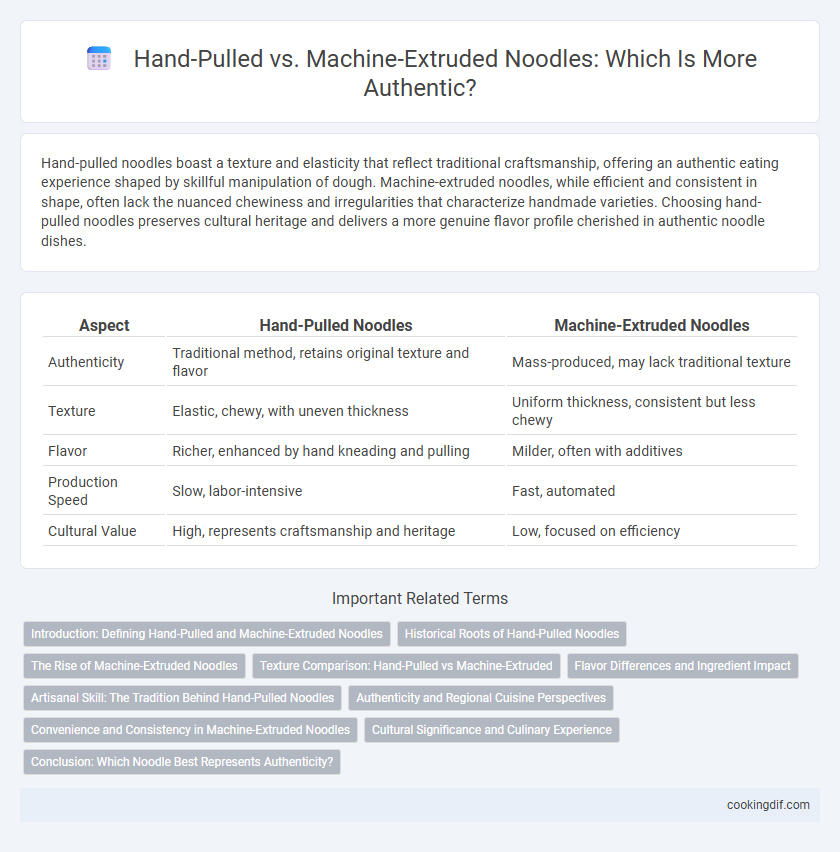Hand-pulled noodles boast a texture and elasticity that reflect traditional craftsmanship, offering an authentic eating experience shaped by skillful manipulation of dough. Machine-extruded noodles, while efficient and consistent in shape, often lack the nuanced chewiness and irregularities that characterize handmade varieties. Choosing hand-pulled noodles preserves cultural heritage and delivers a more genuine flavor profile cherished in authentic noodle dishes.
Table of Comparison
| Aspect | Hand-Pulled Noodles | Machine-Extruded Noodles |
|---|---|---|
| Authenticity | Traditional method, retains original texture and flavor | Mass-produced, may lack traditional texture |
| Texture | Elastic, chewy, with uneven thickness | Uniform thickness, consistent but less chewy |
| Flavor | Richer, enhanced by hand kneading and pulling | Milder, often with additives |
| Production Speed | Slow, labor-intensive | Fast, automated |
| Cultural Value | High, represents craftsmanship and heritage | Low, focused on efficiency |
Introduction: Defining Hand-Pulled and Machine-Extruded Noodles
Hand-pulled noodles are crafted by stretching and folding dough repeatedly to create thin, elastic strands, reflecting traditional Asian culinary techniques. Machine-extruded noodles are produced by forcing dough through molds, enabling uniform shapes and rapid mass production. The contrast highlights hand-pulled noodles' artisanal texture and authenticity versus machine-extruded noodles' efficiency and consistency.
Historical Roots of Hand-Pulled Noodles
Hand-pulled noodles trace their origins back over a thousand years to the Tang Dynasty of China, embodying centuries of culinary tradition and artisanal skill. Each strand is meticulously crafted by hand, preserving the authentic texture and elasticity that mechanical extrusion methods often fail to replicate. The historical roots of hand-pulled noodles emphasize cultural heritage and craftsmanship, which are integral to their distinctive flavor and mouthfeel.
The Rise of Machine-Extruded Noodles
Machine-extruded noodles have surged in popularity due to their consistent texture, faster production times, and lower costs, making them a practical choice for mass markets. While hand-pulled noodles retain a unique stretchiness and artisanal quality that appeals to traditionalists, machines replicate many textures with precision, enabling widespread availability. The rise of machine extrusion reflects a balance between maintaining noodle authenticity and meeting modern demand for efficiency and scalability.
Texture Comparison: Hand-Pulled vs Machine-Extruded
Hand-pulled noodles exhibit a unique, chewy texture with irregular thickness that enhances their authenticity, creating a satisfying bite. Machine-extruded noodles offer uniformity and consistency but often lack the nuanced elasticity and bite found in hand-pulled varieties. The distinct tactile experience of hand-pulled noodles remains a key attribute prized in traditional culinary practices.
Flavor Differences and Ingredient Impact
Hand-pulled noodles offer a distinct texture and flavor profile due to the artisanal stretching process, which enhances gluten development and creates a chewier bite, intensifying the taste experience. Machine-extruded noodles tend to have a uniform shape but may lack the nuanced bite and elasticity, slightly diminishing the depth of flavor compared to hand-pulled counterparts. Ingredient quality, such as high-protein wheat flour, plays a crucial role in both methods, but hand-pulled noodles better showcase ingredient integrity through traditional dough handling techniques.
Artisanal Skill: The Tradition Behind Hand-Pulled Noodles
Hand-pulled noodles showcase exceptional artisanal skill, requiring years of practice to master the intricate dough stretching and folding techniques that create their unique texture. This traditional method imparts a chewy, elastic quality that machine-extruded noodles often lack due to uniform shaping and rapid production. The authentic craftsmanship behind hand-pulled noodles preserves cultural heritage and delivers a distinctive culinary experience unmatched by mechanized processes.
Authenticity and Regional Cuisine Perspectives
Hand-pulled noodles offer unparalleled authenticity by preserving traditional techniques central to regional Chinese cuisine, resulting in unique textures and flavors that machine-extruded noodles often lack. The artisanal process of manually stretching dough reflects cultural heritage and regional culinary artistry, especially in provinces like Shanxi and Shaanxi where hand-pulling is integral to local identity. Machine-extruded noodles provide consistency and efficiency but may sacrifice the nuanced taste and elasticity that connoisseurs associate with authentic hand-pulled varieties.
Convenience and Consistency in Machine-Extruded Noodles
Machine-extruded noodles offer unmatched convenience and consistency, producing uniform thickness and texture that meet high-volume demands efficiently. This automated process reduces preparation time and labor costs, making it ideal for commercial kitchens and fast-paced environments. While hand-pulled noodles provide traditional authenticity, machine-extruded noodles ensure reliable quality control and scalability without compromising taste.
Cultural Significance and Culinary Experience
Hand-pulled noodles embody traditional craftsmanship with each strand crafted by skilled artisans, preserving cultural heritage and enhancing textural authenticity. The tactile experience of pulling dough by hand results in varied thickness and chewiness, offering a rich culinary sensation prized in regional cuisines. Machine-extruded noodles provide consistency and efficiency but often lack the nuanced flavor and cultural depth inherent in hand-pulled noodle preparation.
Conclusion: Which Noodle Best Represents Authenticity?
Hand-pulled noodles exemplify authenticity through their traditional preparation, unique texture, and artisanal craftsmanship, reflecting cultural heritage in every strand. Machine-extruded noodles offer consistency and efficiency but lack the irregularities and tactile qualities that define hand-pulled varieties. For an authentic culinary experience, hand-pulled noodles best represent the genuine craftsmanship and sensory characteristics rooted in traditional noodle-making.
Hand-pulled noodles vs machine-extruded noodles for authenticity Infographic

 cookingdif.com
cookingdif.com